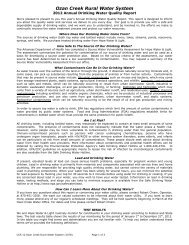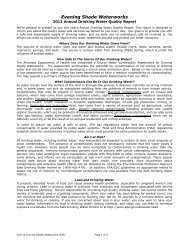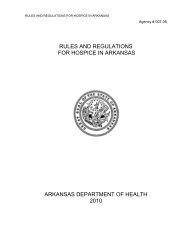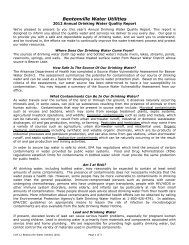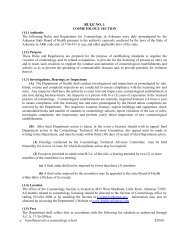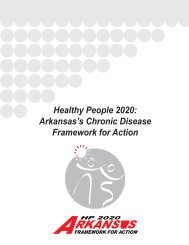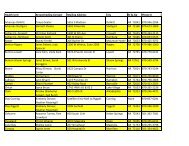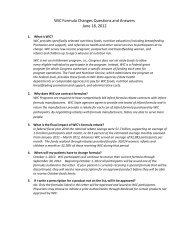Guidelines for Pool and Spa Operators - Arkansas Department of
Guidelines for Pool and Spa Operators - Arkansas Department of
Guidelines for Pool and Spa Operators - Arkansas Department of
Create successful ePaper yourself
Turn your PDF publications into a flip-book with our unique Google optimized e-Paper software.
Disease <strong>and</strong> Accident Prevention<br />
A routine <strong>and</strong> frequent disinfection program should be implemented <strong>for</strong> disease<br />
<strong>and</strong> accident prevention. The following should be used to protect the public<br />
<strong>and</strong> YOU as an operator:<br />
‣ Maintain proper disinfection residual (refer to page 5). During heavy use, especially in hot weather when<br />
temperature is above 84 degrees F, or if you use a stabilizer, keep the chlorine residual at or above 1.5 ppm.<br />
‣ Diving board rules should be posted in pool area <strong>and</strong> no diving allowed in water less than 5 ft.<br />
‣ A visible warning sign should be affixed on the door or near the entrance <strong>of</strong> the chlorine/chemical room(s).<br />
‣ Persons with open wounds, wearing adhesive b<strong>and</strong>ages, infections or sickness should not enter the pool.<br />
‣ Any suits or towels <strong>for</strong> public use must be properly laundered.<br />
‣ Require all patrons to take a soap shower <strong>and</strong> en<strong>for</strong>ce it.<br />
‣ No food, gum, or glass containers allowed in pool area.<br />
‣ Disease causing pathogens can also be present on surfaces in poolside areas such as: spas, benches, seats, decking<br />
<strong>and</strong> other areas people share. Locker rooms <strong>and</strong> toilet facilities need to be disinfected frequently during operation<br />
hours, especially decks <strong>and</strong> seats. You can use 5-6% household bleach ratio <strong>of</strong> 1 cup bleach <strong>for</strong> every gallon <strong>of</strong><br />
water used.<br />
Posters explaining such things as: food items, combs, bathing suits, towels, showers, wounds <strong>and</strong> sickness can help<br />
educate the public on such issues are encouraged. (see Appendix) Posters may also be downloaded from the Center<br />
<strong>for</strong> Disease Control website: www.cdc.gov/healthyswimming/posters.htm<br />
_____________________________________________________________________________________________<br />
Specific Disease Concerns<br />
1) Intestinal diseases: typhoid fever, paratyphoid fever, amoebic dysentery, leptospirosis, bacillary dysentery, etc<br />
Fecal (enteric) related illnesses: salmonellosis, shigella, adenoviruses, noroviruses, etc<br />
2) Respiratory diseases: rhinoviruses, sinusitis, <strong>and</strong> sore throat can spread easier in swimming areas due to low or<br />
no disinfection agents, close contact, <strong>and</strong> moisture. HVAC needs to be checked regularly to ensure proper<br />
working order.<br />
3) Eye, ear, nose, throat, <strong>and</strong> skin infections: the exposure <strong>of</strong> delicate mucous membranes, the movement <strong>of</strong><br />
harmful organisms into the ear <strong>and</strong> nasal passages, <strong>and</strong> even overuse <strong>of</strong> water treatment chemicals can contribute<br />
to different kinds <strong>of</strong> infection.<br />
4) Disease causing pathogens which transmit staph, impetigo, athlete‘s foot, dermatitis, etc. can also be present in<br />
the locker room, on floors <strong>and</strong> benches, <strong>and</strong> on the pool decking.<br />
12




